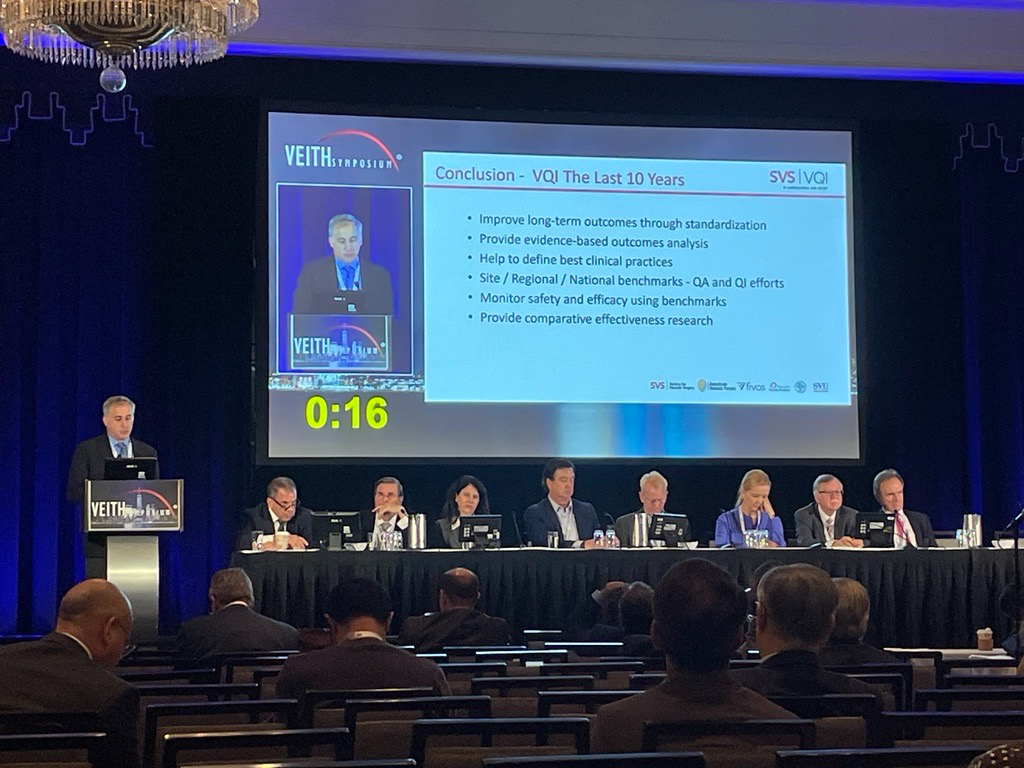
At the recent VEITHsymposium (19–23 November, New York, USA), Marc Passman (University of Alabama at Birmingham, Birmingham, USA) reflected on the achievements of the Society for Vascular Surgery (SVS) Vascular Quality Initiative (VQI) venous arm, in collaboration with the American Venous Forum (AVF), since its inception 10 years ago.
Passman, who is chair of the VQI Venous Quality Council (VQC), shared that a total of 1,302,849 procedures have been captured by the VQI as a whole as of 1 November 2024.
Regarding venous interventions, Passman specified that there are currently three venous modules within the VQI, with varicose vein, inferior vena cava (IVC) filter, and venous stent procedures comprising 70,097, 19,793 and 305 of the November 2024 total, respectively.
Passman first highlighted data from the VQI IVC filter registry. Initiated in 2014, the presenter shared that 50 centres were subscribed to the registry as of November 2024, which is the latest participation datapoint available from the registry. He noted that this has decreased by 16 from a peak in July 2017 of 66 centres subscribed.
Participation in the varicose vein registry shows a similar trend, Passman highlighted. Following its inception in 2015, the number of centres subscribed peaked at 45 in May 2021 ahead of falling by 13 to 32 centres as per the latest figures from November 2024.
The venous stent registry was the most recent of the three venous modules to be established. Passman reported that the number of centres subscribed has been on an upwards trajectory since data capture began in 2020 and currently stands at 10. Providing an update on this newest of the venous VQI registries, Passman noted that there has been a recent revision of the original data fields. Specifically, he shared that less-needed registry variables have been removed and highlighted efforts to decrease registry data entry burden. Passman also detailed that the development of registry reporting measures is now underway, as well as a drive to increase site recruitment.
Moving on to consider how the three venous VQI registries can be used to encourage best practice, Passman shared that a VQI best practices dashboard has been introduced across the board to summarise each individual center’s results, and provide comparison to national VQI benchmarks.
The next topic on the agenda was research, with Passman stating that a venous VQI research advisory council (RAC), chaired by Nicholas Osborne (University of Michigan, Ann Arbor, USA) was set up in 2020. The presenter noted that submission of venous RAC proposals is increasing, and encouraged centres not enrolled in a venous VQI module but are interested in research projects to connect with a venous VQI registry partner. Passman highlighted several publications to have emerged from the venous VQI registries over the past 10 years, including on the impact of COVID-19 on the varicose vein and IVC filter registries and on the use of telemedicine for the management of patients with varicose veins, among various other topics.
In his conclusion, Passman summarised what has been achieved over the past 10 years since the first venous VQI registry was initiated. He highlighted progress in several regards, notably the improvement of long-term outcomes through standardisation, the availability of evidence-based outcomes analysis, and the use of data to define best clinical practices. In addition, Passman underscored the introduction of site and national benchmarks that have the potential to monitor safety and efficacy, as well as the provision of comparative effectiveness research.
Closing the presentation, Passman gave a glimpse of what the next 10 years of the venous VQI might look like. The presenter alluded to the development of additional venous procedural registries, better integration and coordination between venous modules, the expansion of artificial intelligence (AI) initiatives, electronic medical record (EMR) data extraction and finally cross-module, interactive data analysis for better benchmarking and expanded research opportunities.
Speaking to Venous News following his VEITHsymposium presentation, Passman commented on the significance of the last 10 years of the venous VQI: “After a decade of efforts through multiple participants, administrative resources, clinical sites, and research initiatives, venous VQI modules are now poised to be a valuable source of standardised data for improved quality of venous care, benchmarking, and investigation both at the local sites and nationally. With future expansion plans and technological improvement on the near horizon, the next 10 years offers improvement in data accrual and analytical power thereby expanding the value of the venous VQI quality mission.”









